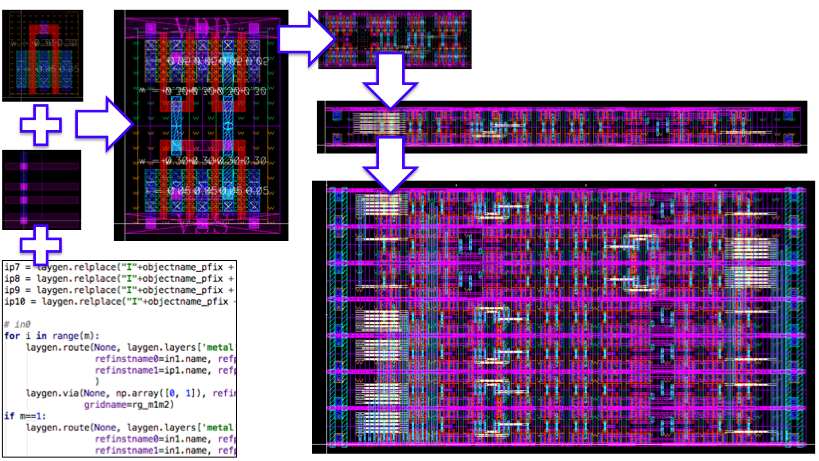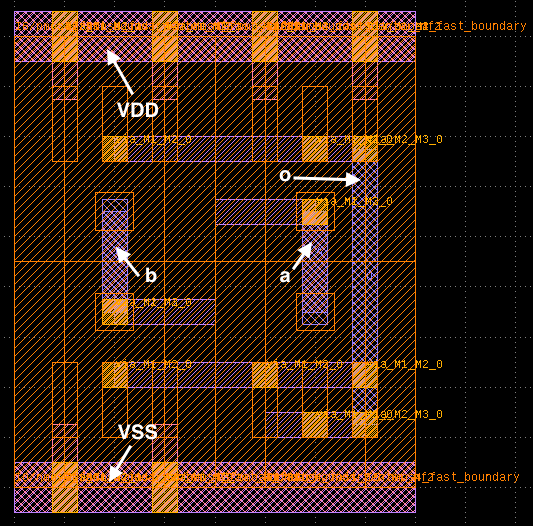LAYGO - LAYout with Gridded Objects¶
Introduction¶
 laygo
laygo
Laygo is an add-on to BAG2 framework, which is developed to generate physical designs (layouts) of integrated circuits (IC) automatically.
Laygo nicely abstracts the complex design rules (which take the most efforts to be cleaned up manually) by introducing template and grid concepts; layout objects are abstracted with their size and port information, and are placed on predefined grids to meet design rules by placement, with their routing wires placed on grids as well. Designers combine these technology-specific templates and grids with technology-independent laygo scripts to produce process-portable and parameterized layouts. The laygo layout generators are written in Python, which provides higher productivity and flexibility to your generators.
The initial versions of laygo have been developed by Jaeduk Han, Woorham Bae, Zhongkai Wang, Eric Jan, and researchers at Berkeley Wireless Research Center (BWRC). The laygo repository is currently being maintained by Prof. Jaeduk Han at Hanyang University.
Getting Started¶
Install BAG2 (skip if you are using the GDS flow).
Clone the laygo repository.
$ git clone git@github.com:ucb-art/laygo.git
Prepare the following setup files for your technology.
laygo_config.yaml - contains general technology information.
An example file can be found here labs/laygo_config.yaml
(technology_name).layermap - (optional) the layer mapping file needed for the GDS flow. Usually the layermap file can be found in your PDK library.
An example layermap file can be found here labs/laygo_faketech.layermap
primitive template and grid database files : contains primitive template and grid information in YAML format.
Example database files can be found here: labs/laygo_faketech_microtemplates_dense_templates.yaml, labs/laygo_faketech_microtemplates_dense_grids.yaml
The primitive template and grid yaml files can be generated from running the following script with the primitive templates and grids constructed by user (check lab2 for details):labs/lab2_a_gridlayoutgenerator_constructtemplate.py
Note 1: an example presets of the setup files for a cadence generic pdk (cds_ff_mpt) is provided for reference. Check this repository for details.
Note 2: For BWRC users, default setup files for various technologies are provided under proper NDAs.
Now you are ready to run a toy script and generate a simple nand gate layout. Launch ipython and run the GDS tutorial script quick_start_GDS.py.
$ start_bag.sh (or ipython) > cd laygo > run quick_start_GDS.py
It will create a nand gate layout, and save it to output.gds.
 qs_nand
qs_nandKLayout was used to display the generated gds file. Detailed explanations on the tutorial script can be found here. You can also export the layout to the BAG framework. Check this document for the details of the BAG flow.
Documentation¶
A complete API documentation can be found here.
Check the following papers for the successful IC generation history using laygo:
[1] E. Chang et al., “BAG2: A process-portable framework for generator-based AMS circuit design,” in Proc. IEEE CICC, Apr. 2018.
[2] J. Han et al., “A generated 7 GS/s 8 b time-interleaved SAR ADC with 38.2 dB SNDR at Nyquist in 16 nm CMOS FinFET,” in Proc. IEEE CICC, Apr. 2019.
Several bootcamp sessions are held at BWRC and other places to introduce laygo to public. Check here to download the bootcamp slides.
Labs¶
Various lab modules are stored in labs/, to provide useful cases to understand the layout generation process. Check this link for details.
Example Generators¶
Example generaters are stored in generators/, with detailed documentations summarized here.